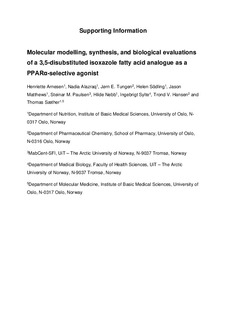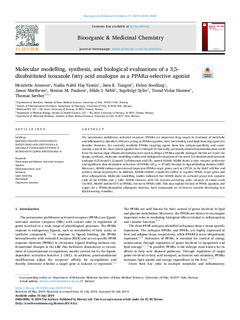| dc.contributor.author | Arnesen, Liv Henriette | |
| dc.contributor.author | Haj Yasein, Nadia | |
| dc.contributor.author | Tungen, Jørn Eivind | |
| dc.contributor.author | Soedling, Helen | |
| dc.contributor.author | Matthews, Jason | |
| dc.contributor.author | Paulsen, Steinar M | |
| dc.contributor.author | Nebb, Hilde Irene | |
| dc.contributor.author | Sylte, Ingebrigt | |
| dc.contributor.author | Hansen, Trond Vidar | |
| dc.contributor.author | Sæther, Thomas | |
| dc.date.accessioned | 2019-09-17T08:10:13Z | |
| dc.date.available | 2019-09-17T08:10:13Z | |
| dc.date.created | 2019-08-24T16:04:02Z | |
| dc.date.issued | 2019 | |
| dc.identifier.citation | Bioorganic & Medicinal Chemistry. 2019, 27 (18), 4059-4068. | nb_NO |
| dc.identifier.issn | 0968-0896 | |
| dc.identifier.uri | http://hdl.handle.net/11250/2617123 | |
| dc.description.abstract | The peroxisome proliferator activated receptors (PPARs) are important drug targets in treatment of metabolic and inflammatory disorders. Fibrates, acting as PPARα agonists, have been widely used lipid-lowering agents for decades. However, the currently available PPARα targeting agents show low subtype-specificity and consequently a search for more potent agonists have emerged. In this study, previously isolated oxohexadecenoic acids from the marine algae Chaetoceros karianus were used to design a PPARα-specific analogue. Herein we report the design, synthesis, molecular modelling studies and biological evaluations of the novel 3,5-disubstituted isoxazole analogue 6-(5-heptyl-1,2-oxazol-3-yl)hexanoic acid (1), named ADAM. ADAM shows a clear receptor preference and significant dose-dependent activation of PPARα (EC50 = 47 µM) through its ligand-binding domain (LBD). Moreover, ADAM induces expression of important PPARα target genes, such as CPT1A, in the Huh7 cell line and primary mouse hepatocytes. In addition, ADAM exhibits a moderate ability to regulate PPARγ target genes and drive adipogenesis. Molecular modelling studies indicated that ADAM docks its carboxyl group into opposite ends of the PPARα and -γ LBD. ADAM interacts with the receptor-activating polar network of amino acids (Tyr501, His447 and Ser317) in PPARα, but not in PPARγ LBD. This may explain the lack of PPARγ agonism, and argues for a PPARα-dependent adipogenic function. Such compounds are of interest towards developing new lipid-lowering remedies. | nb_NO |
| dc.language.iso | eng | nb_NO |
| dc.rights | Attribution-NonCommercial-NoDerivatives 4.0 Internasjonal | * |
| dc.rights.uri | http://creativecommons.org/licenses/by-nc-nd/4.0/deed.no | * |
| dc.title | Molecular modelling, synthesis, and biological evaluations of a 3,5-disubstituted isoxazole fatty acid analogue as a PPARα-selective agonist | nb_NO |
| dc.type | Journal article | nb_NO |
| dc.type | Peer reviewed | nb_NO |
| dc.description.version | publishedVersion | nb_NO |
| dc.source.pagenumber | 4059-4068 | nb_NO |
| dc.source.volume | 27 | nb_NO |
| dc.source.journal | Bioorganic & Medicinal Chemistry | nb_NO |
| dc.source.issue | 18 | nb_NO |
| dc.identifier.doi | 10.1016/j.bmc.2019.07.032 | |
| dc.identifier.cristin | 1718462 | |
| cristin.unitcode | 192,16,2,0 | |
| cristin.unitname | Institutt for mattrygghet og infeksjonsbiologi | |
| cristin.ispublished | true | |
| cristin.fulltext | original | |
| cristin.qualitycode | 1 | |


